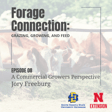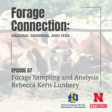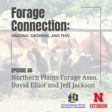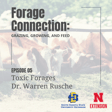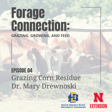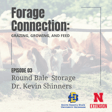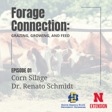Become a Creator today!Start creating today - Share your story with the world!
Start for free
00:00:00
00:00:01

Corn Silage: Dr. Renato Schmidt - Part 2
We continue our conversation with Dr. Renato Schmidt from Lallemand Animal Nutrition about corn silage harvest.
Transcript
Introduction to 'The Forage Connection'
00:00:04
Speaker
It's The Forage Connection, grazing, growing, and feed with your hosts, Ben and Sarah. If you joined us last time, you know that we were unable to fit our entire conversation about corn silage into one episode.
Corn Silage Harvest Insights with Dr. Schmidt
00:00:17
Speaker
We're going to jump right back in where we left off talking about how we can set our machine and get the most out of corn silage harvest with Dr. Hinato Schmidt of Lalament Animal Nutrition.
00:00:27
Speaker
There are just a lot of technical things we can get into with corn silage, right? I mean, you can go down so many paths, but it's true that it's really important that we're putting up good feed after you put all the effort into raising the animal and raising the corn. You want to make sure you're getting it fermented and put up well. But one of the things that I see a lot of producers look past is setting their machines. So depending on what style of harvester you have,
00:00:57
Speaker
or if you're hiring someone to harvest, this can all change depending on your situation. But Dr. Schmidt, what would you want producers to hear in regards to kernel processing and chop length when they're setting their harvesters? Yeah, I think before you get to that point, a good pre-harvest planning, it's important just to inspect. If they're doing their own chopping,
00:01:28
Speaker
to inspect all the equipment, the harvest, everything completely from the tip of the harvest head all the way to the spout. Clean, re-lubricate, and double-check everything is working. See the engine, the safety inspection on fire extinguishers, caution lights. And we're trying just to, on the safety side, of course, but also avoid these costly
00:01:56
Speaker
breakdowns, it prevents some harvest delays. Now on the settings, for the kernel processing, for the rows, I would recommend a row clearance just on average, like around two millimeters, one to three, depending on the situation. And again, I would say you have to always monitor the dry matter. And if it gets to the point that it's really wet or immature, below
00:02:24
Speaker
32% of dry matter is not going to make much of a difference. And if it's above like 40% dry matter, you're not going to start seeing as much as results in terms of processing of the kernels. And that's going to take a lot more in terms of time and fuel and where to turn on the equipment. Average for the chop length, I would say around three quarters of an inch.
00:02:54
Speaker
that would be like an average number. If it's getting a little too much on the dry side, then maybe like a half of an inch, just to make it a little easier for the packing job. But then again, you have to be careful on where to go because if you start getting too short, then you start compromising that effective fiber. For BMR types of hybrids,
00:03:20
Speaker
And, or if it's the corn hybrids a little more on the wet side, you might be touching that one inch, especially if it's a little too wet because then it's less openings on the plant particles to leach some of that juice. And I haven't heard a lot about shreddleage recently. So they had that specific corn kernel processes, but then they go on a longer, longer particle. It's more like an inch to an inch and a half.
00:03:51
Speaker
So we're really using, I guess, those metrics we really hone in once, you know, we've got to get the moisture right first. And that's going to be the really, maybe main pillar when you were talking about your four parts to the stool. Yes. Then we can use these other little things to tweak that a little bit towards the type of, you know, silage that we're really wanting in terms of digestibility or making sure that we're getting proper pack.
00:04:19
Speaker
starch digestibility, all those things. That's correct. It's the dry matter with the starting point and will be in accordance with the maturity of the plant. And then depending on the situation, if it's leaning towards more like a dry mature type of corn plant or a little more immature or wet.
Equipment and Processing Efficiency
00:04:39
Speaker
Also the equipments, when I was in grad school, we did some
00:04:45
Speaker
Just not really an experiment, but we were seeing that the corn that was going through the bagger would have a significantly reduced particle size. So depending on the equipment, it's just another thing to consider. So it's like, oh, I can chop a little longer in the field because it's going to go through all that mechanical processing with the bagger and the particle size will be reduced.
00:05:12
Speaker
I think that's a great point. Once in a while, I work with a producer who doesn't have a kernel processor and they're worried and have questions about that and aren't in a place to get one. But it's like you said, it's all part of tweaking the system. So making sure we're harvesting at the right time and the right moisture is probably the real starting point and the most important thing.
00:05:35
Speaker
Yes, Sarah. And specifically for that type of circumstance, if they don't have a kernel processing, then it's advised to go a little shorter too. So about half of an inch on the corn silage. And if they have available the particle size separator, you know, the Penn State shaker box, it's always like another tool that you can use just to see how it is the distribution of the different particles. When it comes to kernel processing, is that something that
00:06:03
Speaker
you know, we need to be keeping eye on as we're actually harvesting that we can check on or is same with chop length. We set those before we get into the field. Are we just kind of hoping that everything's gonna come out right in the end or is there something that Sarah's holding up a cup now? Leading question here, something that we can be doing while we're actually in the midst of harvest and adjust as we're going.
00:06:31
Speaker
Yes, I would say that there should be a person during the harvest that will check the moisture, the chop length, you know, they're coming from different fields just to have an idea how it is. And for sure, the kernel processing. So the processing cup, it's a really good tool. It's easy. You just fill that cup and you spread the different, you know, the forest particles and you try just find like a whole kernel.
00:06:59
Speaker
And ideally, you're trying not to find any whole kernel. So this is really an easy way to do. There is also one with a bucket of water that you just throw the particles in the bucket of water. And the plant particles will be floating. So you scoop that stuff, and all the kernels will be on the bottom. And you can also, maybe it has a little more in terms of labor, but then
00:07:27
Speaker
it's I think easier just to see all the kernels on the bottom of that pen. And you always hear about these different stories. I mean, I grew up on a farm and I know how it is. And my dad was like that and I'm a little bit like that. Sometimes you question some things, but the producer has, we always have a reason why you do that. So I'm on this online group with different, you know, stylish people. And somebody was saying that,
00:07:56
Speaker
Well, I was harvesting for this producer and I decided just to open the kernel, like stop the kernel processing because it would go easier on the field. It would go faster and save the producer some money. But then all the whole kernels were there. So the producer was like really angry about the whole thing. And the person that did the harvest didn't get it. So it's there. I think there's still some part of these education that
00:08:26
Speaker
We think about producer meetings, but sometimes we have to extend a little to everybody that's involved. So in that case specifically, we're saving a little bit of money on the harvest cost, but we're losing a whole lot on the actual energy that we're extracting from that silage at the end. Exactly. And that's what you're going to have for the whole next year or next season. So that's why it's also important to try to do the best you can because that's
00:08:55
Speaker
That's going to be the feed for a pretty good amount of time.
00:09:00
Speaker
So we've talked about a lot of stuff from the harvest standpoint. We kind of went over the moisture standpoint. We talked about setting the machine here, what we can do.
Inoculants and Fermentation Techniques
00:09:10
Speaker
Last thing kind of in the field, and I'm sure that you have plenty of thoughts on this, is it seems like there's a lot of new products, a lot of new stuff coming out every day in terms of what we can be doing to add to the silage from an inoculant standpoint. What thoughts, what would you have producers consider from
00:09:28
Speaker
what we can be applying to help that microflora for our silage piles? I would say to do like a little homework before. So, you know, learn a little about the inoculants if you're not really familiar what you expect from them. Who is selling? If it's the primary manufacturer, what type of quality and control or even like type of information you can see on the label.
00:09:56
Speaker
information about what type of bacteria, what strains, what amount of bacteria. Some formulations contain enzymes just to feed a little more the bacteria in some challenging or specific situations where sugar is limiting. See, I guess, if there is some independent data, the more data the better, just to showing that the product works. And don't look at
00:10:24
Speaker
cost at first, you know, this is more like an investment. And in terms of types of inoculants, there are some just for that initial phase of fermentation, just to make it more efficient to produce that electric acid. So basically, they can be used in any crop, because you can always make a good fermentation better, you can always get more on dry matter and nutrient retention.
00:10:50
Speaker
And then there is a second type of inoculant. So these are more like a combination type of products because they have this type of bacteria that I just talked about for the front end or the initial fermentation. But there is also a specific strain of latic acid bacteria that helps with the feed out stability. Basically the silage will remain fresh or cooler for a longer period of time.
00:11:18
Speaker
And normally it's by the production of a moderate amounts of acetic acid. And acetic acid, you know, we have that in vinegar, acetic acid works just like propacid. That's the most common, I guess, ingredient of all these TMR preservatives. So depending on the situation, if it's something that I don't have challenged during the feed out, so a producer can always use that front end product.
00:11:46
Speaker
But then in situations that, yeah, it's always hitting or I'm feeding my silage during the hot time of the year, I'm selling to somebody, I'm moving from a place to another, then they should consider the other type of the combination products. And normally they are based on an organism that's called lactobacillus buclarii. Just remember that those are live organisms.
00:12:14
Speaker
You try to keep them away from sunlight, from moisture, heat source. And when you're in the field in the summer and you have the inoculant that's mixed in the water, when that solution starts getting around 90 degrees, then it's time to either throw like a nice pack or a frozen soda bottle, just to make sure that you're not gonna basically cook the bacteria.
00:12:39
Speaker
it seems over the years, inoculant has become more popular and more common. And we're seeing people put it on more readily. And that's great, as long as they're able to find good sources of it, like you said. So we discussed quite a few different things about in the field,
00:12:57
Speaker
how we can really make things come to light and do a good job of managing our silage. When we get to that last step before feed out, we're at the pile or the bunker or the silo. There's a few things we really need to make sure happen so that we get good feed in the end. And I'd say typically thing we need to be most careful about is when we're putting up silage piles or putting silage in bunkers.
00:13:24
Speaker
to make sure that we're doing a good job of packing and covering. So Dr. Schmidt, what suggestions would you have about packing some general rules of thumb or issues you see producers have out there? I think the main challenge nowadays is just these harvesters. They are going through the acres and they have so many tons delivered per hour.
00:13:50
Speaker
So it's a challenge to match that when you're bringing all those loads, you know, to the site to be packed. And oftentimes there's just not enough time for the push tractor to make that six inch or less layer. So that's really important. And it's just hard to find that compromise of the delivery rate of the forage and the packing weight and the packing time. So there's.
00:14:18
Speaker
It's something that you really have, you know, we need to pay attention to, and sometimes you slow down, or I don't know, start doing, if possible, two piles at the same time, because then you'd have like, you kind of like dilute that high tonnage that's coming in. The six, as I said, the six inch layers, they're really important. You know, at the very least, you can spread that and drive through the whole surface. It will make a big difference.
00:14:47
Speaker
I remember I was talking to Dr. Keith Bosen once and he said that he placed a nag under, I don't know if it was nine inches or a foot of that fluffy forage and the tractor, the packing tractor drove over and it didn't break the egg. So it's just, if it's not that little thin layer that you're packing one over the next one and the next and the next and you decide just to go through like a whole foot or even thicker, you're not gonna get rid of the air.
00:15:17
Speaker
So this layer stickiness, it's a big thing. Uh, there is, uh, some, uh, like a quick and dirty, kind of like a cowboy math, they call the 800 rule. So basically it's the amount of forest that are being delivered. Times the 800 factor. And that equals the amount of packing weight that you should have. So just to make it easier, if the delivery rates a hundred tons per hour.
00:15:45
Speaker
then you should have 80,000 pounds of packing weight over the pile. So then sometimes when you think of more like hundreds and hundreds of tons are being delivered, it's almost impossible to have all that packing weight or all that those tractors trying to make a good job. And then there is also the safety aspect that you have all that traffic. So it's another thing that we should consider.
00:16:13
Speaker
So the 100 rules, it's a nice thermometer to see the packing weight, the delivery rate. Also, it's another important factor and the six inch layers. I think those would be like the most important. And another thing to have in mind is the better you pack that forage, not only you're making the fermentation a lot better because you're making everything anaerobic easier, quicker, but then the capacity
00:16:42
Speaker
of that volume, you can pack a lot more tons on that same amount of area. So some people, they say, oh, I don't have the real estate and I have some space. And sometimes you can just increase like a few pounds dry matter per cubic feet of density is going to make a good difference on how many tons you're going to be packing. With that increased use of inoculants, I feel like sometimes working with different folks at
00:17:11
Speaker
feels like, oh, maybe I don't have to worry about packing quite so much because I've got the safety net of inoculants or even moisture content or different things like that. If we're not packing and putting that pile together right and harvesting right, are those inoculants able to basically save us from having bad silage in those cases where we're not keeping an eye on those main factors?
00:17:37
Speaker
Yes, the inoculants are a good two-in-a-box, but they are a two-in-a-box. If you're challenging too much, you cannot just rely on, oh, I'm going to use inoculant, and that's going to take care of the problem. And it's not always like that. I've seen, and I have manuscript research findings showing that the inoculant really saved from the Clostridium fermentation. It saved from nutrient loss during feed-out.
00:18:06
Speaker
But I just had this conversation going through like a report with a producer and the packing density was not really adequate. So also we call porosity. So the porosity was high. And I mentioned, I was like, if this is a challenge, there is that type of product, the inoculant that helps when there is this some problems with the packing, we feed out stability, et cetera. And he told me the same thing you mentioned.
00:18:34
Speaker
Then it's, okay, so if I use these products, I don't have to pack was like, no, I didn't, I didn't say that the best, uh, the better the conditions we give to the inoculants, we're going to get the most out of them. So those would be like the perfect conditions of these, offer these bacteria. So you got enough amount of sugars. We have the proper moisture range. They are under anaerobic condition. So they can do that conversion of sugar, stiletic acid.
00:19:03
Speaker
If there is oxygen around, you know, the lactic acid bacteria survives and it's still active, but just has a different type of metabolism. So it's one of those things like if it's not under the ideal circumstance, then you should not expect like perfect outcome from the fermentation even. In a nutshell, Dr. Schmidt, you can correct me if I'm wrong, but inoculant
00:19:31
Speaker
Like you said, it's a great tool rather than improving necessarily the situation we're in with our silage. It's going to help us maintain what we have, but not going to fix the issues that might be there. Is that a safe statement? Yes. And it just helps with that. Okay. Let's save the most of the dry matter and nutrients just by making the fermentation more efficient.
00:19:57
Speaker
I mean, there is that parenthesis that we discussed about corn silage that over time you have more on that starch digestibility. So it kind of like improves with the storage. And it's more like something that I've been seeing with the reports, some type of inoculants. I'm pretty sure that's helping degrading that protein when I look at the numbers. But in the end of the day, like I said, it's just a tool to help on this
00:20:26
Speaker
process. And recently on a survey that we did, I think unfortunately a lot of producers, they said we use the inoculant, but only when we have some sort of challenge. So it's still that kind of like frame of mind that, oh, I'll have another tool to go around this problem, but not like, let's make the fermentation the best we can.
00:20:54
Speaker
Yes, I think that the more producers understand inoculants and how those processes work, the better tool it can be for them. So really appreciate that comment.
00:21:06
Speaker
When we're discussing working with the pile, another thing that we often see is different types of coverings. Now, dairy producers tend to know their covers and really want to protect that feed. But we have beef producers that have a totally different outlook on their feed. Of course, they want good feed, but they're looking at tonnage more so than they're looking at quality a lot of times if we're feeding out cattle in a feedlot, for example.
00:21:34
Speaker
So what are some things we should look for, especially along lines of beef producers with covering? How quickly should we cover? Is there a certain type of covering producers should be looking at?
Prioritizing Silage Coverage Over Inoculants
00:21:45
Speaker
Yeah, the dairy folks, anything goes wrong in the diet, they see the next day on the milk tank. So they are a lot more sensitive about that. And I see it's a different reality on the feed yards that it's more about, OK, let's get that
00:22:02
Speaker
little bit of scratch factor and more on the tonnage and even sometimes with that you know you see some spoilage and oh it's just about I don't know seven eight percent of the diet but it's still feed it's still like you know you're losing that investment all that stuff that should be converted you to meat. I still see some piles that are not covered and if producer comes to me and say
00:22:31
Speaker
I can only invest either on a plastic or on an inoculant. What should I do? I would say cover the pile, cover your silage. I'm not selling plastic. The company is selling inoculant and I do the tech support for the inoculant products. But I would say, first of all, cover your silage. Not only you have all that surface that's exposed to air and the air will penetrate
00:22:59
Speaker
kind of like easily because it's harder to pack on the top of the surface. And it's also exposed to the elements, to rain and whatever else. So the regular polyethylene plastic, the sheet of plastic, it's fine. If some people, they like to go maybe like a next step. So the oxygen barrier fumes, they've been in the market for a while for, I don't know, at least like 15, maybe 20 years.
00:23:29
Speaker
And I really like them because they just sit over the surface, and it's almost like a surrender app, and they eliminate some of their pockets, in addition to the lower transfusion of oxygen. But if they're using just a single film, a single sheet of plastic, and using the tires and covering everything, you try to do as fast as possible.
00:23:58
Speaker
I've seen a couple of research papers that showed after six hours of that being exposed to air, you start seeing some issues in terms of lower sugar content, bad fermentation. So there's still some window. And as they're making the pile, if they can just cover as they go, that would be ideal. But I always cover.
00:24:23
Speaker
How about covering timing, Hanato? When we're talking about putting up that silage, how quick after the pile is packed should we be covering it? As soon as possible. Ideally, you finish packed and you get some crew or some people that will start covering. You try to get that air out of the system as fast as you can. Because when you think of the pile,
00:24:51
Speaker
And all that circumference, all the outside, it represents a lot of feed that's exposed to air. So it's already hard enough to pack those final layers. And if it's still allowing the oxygen to penetrate, it's just going to become more and more of a challenge. So again, there is those studies that set something around six hours. After six, sometimes nine hours, you still keep that quality
00:25:22
Speaker
on the silage, but then past that you start seeing some more, you know, challenges in terms of sugar amounts for the fermentation. Uh, the topic starts getting drier and even harder when you cover and then we start increasing the, the risk of molding. One of the challenges when you look at the degradation of a silage pile, especially when you don't cover it, that mold layer or that, that layer on top,
00:25:49
Speaker
gets compacted. And so it a lot of times looks like, oh, we're not losing that much to spoilage on top. You know, you took all of that pretty big chunk of the, when you look at the surface area on the outside of a pile and you run the math on it.
00:26:04
Speaker
and it shrinks down, it looks a lot less than what we're actually losing. And then we're also losing it, you know, like you said, to mold and dry matter loss beyond just the loss of nutrients, we're actually physically losing some of our feed from that standpoint, too. Yes. And when you look at that cross, you know, that top layer, that black cross that it, you know, we normally see, it represents
00:26:32
Speaker
three times the thickness of the original layer of the fresh forage. So it is, it is a considerable amount of feed that it just got spoiled and compressed on that black layer. And there's still, there's still going to be a little bit of a gradient, a little transition until you finally reach that, you know, good silage, let's say. And, uh, on some, some data from Dr. Bolson on three different crops, it showed that if you don't cover
00:26:59
Speaker
And that's what's for alfalfa, corn and sorghum. On the top 10 inch, you lose, they lost almost 80% of the material on that 10 inch layer. So that's a lot. That's a lot of dollars right there and a lot of time.
00:27:21
Speaker
So if we get everything done correctly and we've put up our pile, we've used the right inoculants, we covered it like we were supposed to, eventually we've got to open the whole thing up and start using that product. We mentioned a little bit before, how long does that pile need to sit ideally, especially when we're looking at corn silage and then what recommendations do you have when we're looking at actually going about the feed out process to maintain quality? During storage,
00:27:50
Speaker
I would say it's not a bad idea just to, you know, inspect, especially the plastic or if it's a bag silo, you know, look for some sort of damage or holes and, and just like put some sort of tape. There's a specific tape for that. And, you know, it's, it's, it's good to rub some alcohol. So the tape sticks a lot better.
Maintaining Quality During Feed-Out
00:28:10
Speaker
You get some of that wax off. And, uh, during feed out, you know, you try to go through the entire phase.
00:28:20
Speaker
at least six inches every day so that will be recommended and you're just winning that war against the oxygen that's penetrating the face. If you can go a little faster on like challenging times or if it's heating or poorly packed that would be advisable but once you have everything on a pile it's kind of like it is what it is. It's always important to design that pile you know
00:28:48
Speaker
In terms of piles, of course, you can change. It's important to design based on the feed out per day. For example, I need this many tons. I have this particular width or height and the length. So how can I calculate this volume and go six inch or nine inch every day? So go through the whole phase, six inch per day at least.
00:29:19
Speaker
try to minimize damage on the face and when everything is nice and straight you have less of a surface area that's exposed to air and also it's safer so if you can you know when removing with for example a rake you try to do on a backwards type of angle so you can avoid overhangs
00:29:46
Speaker
And not to leave any material, just try to get the most out of the front of the silage, not leave some silage that will be fermenting or spoiling all the way to the next day. And you mix that silage that's been spoiling with some good silage.
00:30:03
Speaker
So when we're, when we're talking about proper feed out, that really goes back to the initial development somewhat. We don't want to be creating a pile that's too big so that we can't maintain that proper six inches per day. So we really have to be thinking about that before we even start harvest here this year, if we're putting our pile up somewhat. Is that correct? Yes, that's a hundred percent correct. You do that proper pile design.
00:30:30
Speaker
And it would be a lot easier to do that feed out management. And I have all these questions very frequently. It's all, which one is better is to go like a halfway on the pile and come back to the other half or just go really slow across the face. And it is almost, it's almost like, well, you need to take a shot. You want the left arm or the right arm? It's, you're still going to have that issue with the oxygen that's penetrating, you know, on the first example,
00:30:59
Speaker
that a half of side that's going to be exposed or on the on the feet out face that it's too large. So depending on the situation, the air can penetrate as deep as four feet. So it's you know, it's hard just to keep that that face fresh, if you will.
00:31:16
Speaker
So maybe one of the main points people can really do to minimize losses with face feed out is just keep that as vertical and as slimmed up as they can and try not to leave silage sitting off to the sides in the corners of the pile or the bag. Yes. And if you can leave a little like a concave aspect so you're not creating like an overhang, that's a good idea too. You know, at the end of the day,
00:31:46
Speaker
getting air out of that, the whole system. So in the, you know, in the beginning, you just want that fermentation. Like if we do, you know, folks that do some Kenny or fermenting at home, what are you doing? Make the brine, you put some veggies or whatever you want to pickle and you need to put away on the top. So it's not in contact with air. Otherwise we'll, you know, we start seeing molding and all that stuff. And during feed out, I really like to do analogy with, uh, with a loaf of bread that
00:32:14
Speaker
You know, you look at the ingredients, there is some preservative like the organic acids in the silage. You open the bag and you take a slice and another day, you know, almost like feeding out of the bunker and you're getting close to that expiration date. So it's like, Oh, okay. Let me place my bread and think about another way to preserve it. So, Oh, let's put in the fridge. So the low temperature is still going to keep the, you know, the microbes quiet.
00:32:42
Speaker
But at some point you open that fridge, you squeeze another week or 10 days. One day you open the fridge and you see all the molds like the red and gray. So everything has this, you know, expiration date and the oxygen. It's one of pretty much the main factor.
00:32:59
Speaker
everything but a Twinkie, right? They can pretty much count on it molding. So this has been great information, Dr. Schmidt, on how we can manage our corn in the field, put up good silage, keep it stored well, and feed it out. But none of that matters if we have a silage-related accident.
00:33:23
Speaker
So what
Safety Measures in Silage Handling
00:33:24
Speaker
are some things that producers can keep in mind to keep themselves and their employees and family members from getting complacent and being unsafe? I think the most important is that, you know, don't be complacent. It's that mentality that, oh, come on, I've been doing this all my life. I know about everything. And sometimes you just don't pay attention. And when something happens, then it's just too late. You get to that
00:33:54
Speaker
Oh my God, moment, you know, that's it. And even on some, uh, on some, let's say some strategies, for example, an employee would be in the front of the face of the pile. And he has like a rope that it's connected or a harness or something, but then there is an avalanche. And even if you survive, when you'll be pulling, you know, the person out of that to silage,
00:34:21
Speaker
I don't know how many, if there would be any bones that would be intact. I mean, we talk about the density or the packing density of the silage that we recommend about 45 pounds fresh matter per cubic feet. So in one cubic feet, it's 45 pounds that could be like, you know, falling in your head.
00:34:44
Speaker
So it's always, you know, be careful, uh, train everybody on that operation. Make sure you keep the record. So it's safe for the employee and the employer. Always have somebody with you called the buddy system. And, uh, at least somebody that knows where you are working and be aware of your surroundings. So always, you know, stop and listen and look.
00:35:13
Speaker
And as you said, if safety is not there, then nothing else matters. I know you mentioned earlier Dr. Keith Bolson a couple of times. He has passed away but was a great researcher out of Texas. And he started, him and his wife Ruthie started something called the Bolson Safety Foundation.
00:35:34
Speaker
And there is some great resources there. If you're looking for more resources, silagesafety.org is one place that producers or anyone can go to get information on being safe with silage, making sure everyone goes home safe, and providing information to employees. I think safety, like you said, is really the most important thing at the end of the day.
00:36:00
Speaker
Yes. On the technical side, we discuss about all these different steps and they are equally important. So if there is something wrong with the quality of the initial material or the packing job, there will be a problem in the end or a lower quality. That's what I mean. And yeah, we try just to get the most out of our crops and either convert to milk, meat.
00:36:28
Speaker
and do this on a safe way. Well,
Contact Information for Further Inquiries
00:36:33
Speaker
Dr. Schmidt, we really want to thank you for taking some time to talk with us. I know, you know, people listening, it seems like everyone's got a unique circumstance or situation sometimes. If they'd like to reach out to you personally, is there a good way to get in contact with you? Yes. My email is R. Schmidt.
00:36:54
Speaker
at the Lalaman dot com. So our Schmidt at Lalaman dot com. And that's everybody is more than welcome to reach me to send me a note or my cell number. Also, it's four zero two eight five zero eight zero eight nine. So anytime there is a question or any comments or anything that silage related and they need like a second opinion, I'll be more than happy to help.
00:37:23
Speaker
Thank you so much Dr. Schmidt again for joining us today. And thank all of you for listening in and joining us for the Forage Connection.
